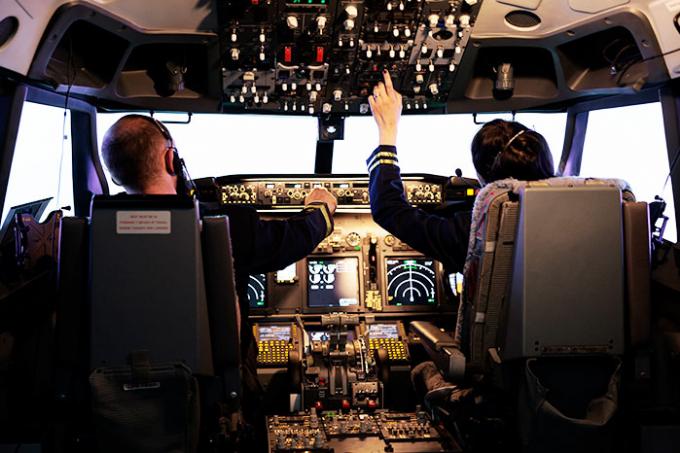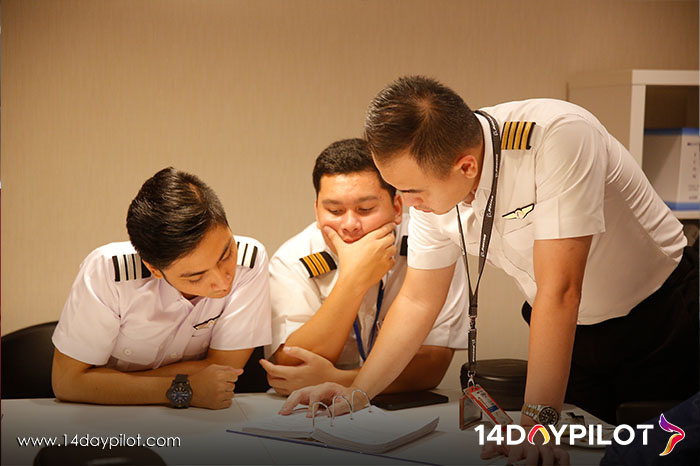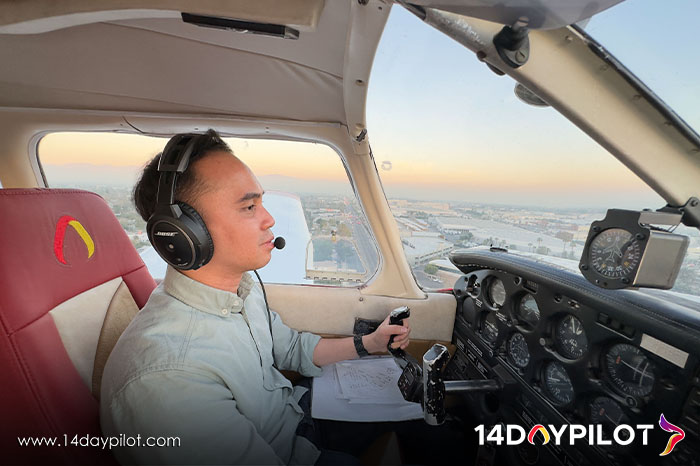
Read More: Spatial Disorientation: Tips to Manage It in Flight Training
What: Situational awareness is the ability to perceive the elements in your environment, understand their meaning, and predict their future status. Endsley’s model divides it into three levels:
Level 1: Perception of elements such as weather, traffic, and instruments.
Level 2: Comprehension of their significance.
Level 3: Projection of future events.
Why: Maintaining SA is crucial for identifying and addressing risks, such as instrument malfunctions or changes in air traffic.
Why: Maintaining SA is crucial for identifying and addressing risks, such as instrument malfunctions or changes in air traffic.
When: SA is most vital during high-stress scenarios like instrument approaches, adverse weather, or system failures.
Who: All pilots, regardless of experience, must hone SA skills, though it’s especially critical for trainees.
Where: In the cockpit, SA involves monitoring instruments, airspace, and flight paths.
How: Through deliberate practice, mental models, and continuous assessment of your environment.
While SA is essential, it’s also one of the most challenging aspects of flying. Here are some common obstacles:
Non essential tasks, such as unnecessary conversations or cockpit noise, can pull focus from critical elements.
High workloads during instrument approaches can lead to tunnel vision, where you focus too narrowly on one aspect.
Prolonged periods of high concentration or personal stress can degrade cognitive abilities, reducing SA.
Fixation: Over-focusing on one issue.
Complacency: Assuming everything is fine without verifying.
Overload: Trying to handle too much information.
Fatigue: Reduced mental performance.
Inexperience: Limited exposure to complex scenarios.
Poor Training: Lack of preparation for real-world challenges.

Maintaining Situational Awareness While Flying
(Source Picture: Documentation by 14DAYPILOT)
Developing strong scanning techniques is vital for maintaining awareness of your surroundings and the aircraft’s state. Use systematic patterns to check instruments, ensuring no critical detail is overlooked.
Adopt the “sterile cockpit” rule during critical phases like takeoffs and approaches. Minimize non-essential tasks to maintain focus.
Building mental models helps anticipate future scenarios. For example, visualize how changing wind speeds might affect your approach.
Leverage tools like GPS, synthetic vision, and advanced displays to enhance SA. However, ensure these tools support rather than replace your vigilance.
Continuously evaluate altitude, heading, speed, and potential hazards to remain proactive rather than reactive.

Strategies to Prevent Situational Awareness Loss
(Source Picture: Documentation by 14DAYPILOT )
Simulate potential malfunctions to practice staying composed under pressure. Techniques like “Aviate, Navigate, Communicate” help prioritize actions effectively.
Recognize signs of fatigue or cognitive overload and address them proactively. Take breaks and use effective workload management techniques.
Communicate clearly with ATC and your co-pilot to maintain shared situational awareness, especially in high-traffic or challenging environments.
Read More: How to Land an Airplane for Solo Flight: A Beginner’s Guide
In Simulators: Simulate complex scenarios to identify weak points in your SA. Practice responding to emergencies like instrument failures or sudden weather changes.
In Flight: Divide tasks into manageable segments and use checklists to maintain focus during critical phases of flight.
Mastering situational awareness is not just about improving your skills but ensuring your safety and that of your passengers. By focusing on perception, comprehension, and projection, you can navigate complex scenarios with confidence.
Ready to elevate your skills? Enroll in 14DAYPILOT’s Instrument Rating Program and master situational awareness through accelerated training. Train with experienced CFIs and real-world scenarios to gain the edge you need. Join 14DAYPILOT The World’s Best Accelerated Flight School today and achieve your aviation dreams!

Situational awareness (SA) is one of the most critical skills a pilot can develop, particularly during instrument training where external visibility is often limited. It refers to a pilot’s ability to perceive, understand, and anticipate their surroundings, enabling safe and effective decision-making. In this guide, we’ll explore what situational awareness means, the challenges pilots face in maintaining it, and practical strategies to ensure it becomes second nature in your training.
Read More: Spatial Disorientation: Tips to Manage It in Flight Training
What: Situational awareness is the ability to perceive the elements in your environment, understand their meaning, and predict their future status. Endsley’s model divides it into three levels:
Level 1: Perception of elements such as weather, traffic, and instruments.
Level 2: Comprehension of their significance.
Level 3: Projection of future events.
Why: Maintaining SA is crucial for identifying and addressing risks, such as instrument malfunctions or changes in air traffic.
Why: Maintaining SA is crucial for identifying and addressing risks, such as instrument malfunctions or changes in air traffic.
When: SA is most vital during high-stress scenarios like instrument approaches, adverse weather, or system failures.
Who: All pilots, regardless of experience, must hone SA skills, though it’s especially critical for trainees.
Where: In the cockpit, SA involves monitoring instruments, airspace, and flight paths.
How: Through deliberate practice, mental models, and continuous assessment of your environment.
While SA is essential, it’s also one of the most challenging aspects of flying. Here are some common obstacles:
Non essential tasks, such as unnecessary conversations or cockpit noise, can pull focus from critical elements.
High workloads during instrument approaches can lead to tunnel vision, where you focus too narrowly on one aspect.
Prolonged periods of high concentration or personal stress can degrade cognitive abilities, reducing SA.
Fixation: Over-focusing on one issue.
Complacency: Assuming everything is fine without verifying.
Overload: Trying to handle too much information.
Fatigue: Reduced mental performance.
Inexperience: Limited exposure to complex scenarios.
Poor Training: Lack of preparation for real-world challenges.

Maintaining Situational Awareness While Flying
(Source Picture: Documentation by 14DAYPILOT)
Developing strong scanning techniques is vital for maintaining awareness of your surroundings and the aircraft’s state. Use systematic patterns to check instruments, ensuring no critical detail is overlooked.
Adopt the “sterile cockpit” rule during critical phases like takeoffs and approaches. Minimize non-essential tasks to maintain focus.
Building mental models helps anticipate future scenarios. For example, visualize how changing wind speeds might affect your approach.
Leverage tools like GPS, synthetic vision, and advanced displays to enhance SA. However, ensure these tools support rather than replace your vigilance.
Continuously evaluate altitude, heading, speed, and potential hazards to remain proactive rather than reactive.

Strategies to Prevent Situational Awareness Loss
(Source Picture: Documentation by 14DAYPILOT )
Simulate potential malfunctions to practice staying composed under pressure. Techniques like “Aviate, Navigate, Communicate” help prioritize actions effectively.
Recognize signs of fatigue or cognitive overload and address them proactively. Take breaks and use effective workload management techniques.
Communicate clearly with ATC and your co-pilot to maintain shared situational awareness, especially in high-traffic or challenging environments.
Read More: How to Land an Airplane for Solo Flight: A Beginner’s Guide
In Simulators: Simulate complex scenarios to identify weak points in your SA. Practice responding to emergencies like instrument failures or sudden weather changes.
In Flight: Divide tasks into manageable segments and use checklists to maintain focus during critical phases of flight.
Mastering situational awareness is not just about improving your skills but ensuring your safety and that of your passengers. By focusing on perception, comprehension, and projection, you can navigate complex scenarios with confidence.
Ready to elevate your skills? Enroll in 14DAYPILOT’s Instrument Rating Program and master situational awareness through accelerated training. Train with experienced CFIs and real-world scenarios to gain the edge you need. Join 14DAYPILOT The World’s Best Accelerated Flight School today and achieve your aviation dreams!
Ilham Febrian is a dedicated aviation blogger with a strong interest and high expectations for the aviation industry. He holds a DGCA Commercial Pilot license with Airbus A320 type rating. Continuously updated with the latest aviation news, Ilham strives to provide top-quality content on the website, aimed at assisting all pilots. The website focuses on offering flight training guidance, information on flying school materials, and tips on how students can successfully pass their check rides.
Ilham Febrian is a dedicated aviation blogger with a strong interest and high expectations for the aviation industry. He holds a DGCA Commercial Pilot license with Airbus A320 type rating. Continuously updated with the latest aviation news, Ilham strives to provide top-quality content on the website, aimed at assisting all pilots. The website focuses on offering flight training guidance, information on flying school materials, and tips on how students can successfully pass their check rides.